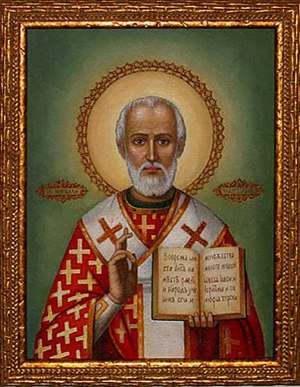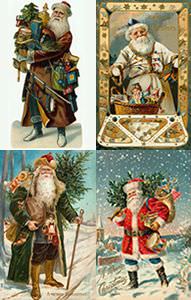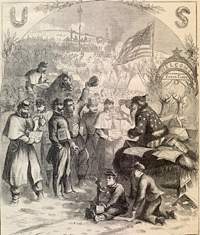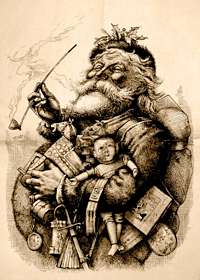http://www.stnicholascenter.org/pages/real-santa/

 The real Santa lived a long time ago in a place called Asia Minor. It is now the country of Turkey. His name was Nicholas.
The real Santa lived a long time ago in a place called Asia Minor. It is now the country of Turkey. His name was Nicholas.
Nicholas’ parents died when he was just a teenager. His parents left him a lot of money which made him a rich young man. He went to live with his uncle who was a priest.
Nicholas heard about a man who had lost all his money. He had three daughters who were old enough to get married. But in those days young women had to have money in order to get married. This money was a “dowry” and it was used to help the new family get started. If you didn’t have dowry money, you didn’t get married.
This family was so poor they had nothing left to eat. The daughters were going to be sold as slaves because they couldn’t live at home any longer. They were very sad. They wouldn’t be able to have families of their own. And they would have to be slaves—no longer able to decide where they would live or what they would do.
The night before the oldest daughter was to be sold, she washed her stockings and put them in front of the fire to dry. Then all of them went to sleep—the father and the three daughters.
In the morning the daughter saw a lump in her stocking. Reaching in, she found a small, heavy bag. It had gold inside! Enough to provide food for the family and money for her dowry. Oh, how happy they were!
The next morning, another bag with gold was found. Imagine! Two of the daughters would now be saved. Such joy!
And the next night, the father planned to stay awake to find out who was helping his daughters. He dozed off, but heard a small “clink” as another bag landed in the room. Quickly he jumped up and ran out the door. Who did he catch ducking around the corner?
Nicholas, the young man who lived with his uncle. “Nicholas, it is you! Thank you for helping us—I hardly know what to say!” Nicholas said, “Please, do not thank me—thank God that your prayers have been answered. Do not tell others about me.”


Nicholas continued helping people. He always tried to help secretly. He didn’t want any attention or thanks. Years passed and he was chosen to be a bishop. Bishops look after their people as shepherds look after their sheep. And that is what Nicholas did. When there wasn’t any food, he found wheat; so no one went hungry. He always helped people in trouble. All his life Nicholas showed people how to love God and care for each other.
Everyone loved Nicholas. After he died, they told stories of the good and kind things Nicholas had done. Sailors took these stories about Nicholas everywhere they went. Some of the stories were about his special care for children—helping and protecting them when danger threatened. And so more and more people learned about good, kind Nicholas. They wanted to be like him. He is an example of how we should live. And that is why he became a saint.
This is the story of the real Santa Claus, St. Nicholas. To this day people say that St. Nicholas, or Santa, is the special friend of children.
—Carol MyersPost-reading: http://www.stnicholascenter.org/pages/kids-map/
GAMES: http://www.stnicholascenter.org/pages/gift-game/
http://www.stnicholascenter.org/pages/word-search-2/
http://www.stnicholascenter.org/pages/word-search-1/
пазл: http://www.stnicholascenter.org/media/assets/jigsaw_puzzles/jigsaw_puzzles.html
http://www.whychristmas.com/customs/fatherchristmas.shtml
 St. Nicholas, Santa Claus & Father Christmas
St. Nicholas, Santa Claus & Father Christmas 
The Man Behind the Story of Father Christmas/Santa Claus
St. Nicholas was a Bishop who lived in the fourth century in a place called Myra in Asia Minor (now called Turkey). He was a very rich man because his parents died when he was young and left him a lot of money. He was also a very kind man and had a reputation for helping the poor and giving secret gifts to people who needed it. There are several legends about St. Nicholas, although we don’t know if any of them are true!

www.stnicholascenter.org
The most famous story about St. Nicholas tells how the custom of hanging up stockings to get presents in first started! It goes like this:
There was a poor man who had three daughters. He was so poor, he did not have enough money for a dowry, so his daughters couldn’t get married. (A dowry is a sum of money paid to the bridegroom by the brides parents on the wedding day. This still happens in some countries, even today.) One night, Nicholas secretly dropped a bag of gold down the chimney and into the house (This meant that the oldest daughter was then able to be married.). The bag fell into a stocking that had been hung by the fire to dry! This was repeated later with the second daughter. Finally, determined to discover the person who had given him the money, the father secretly hid by the fire every evening until he caught Nicholas dropping in a bag of gold. Nicholas begged the man to not tell anyone what he had done, because he did not want to bring attention to himself. But soon the news got out and when anyone received a secret gift, it was thought that maybe it was from Nicholas.
Because of his kindness Nicholas was made a Saint. St. Nicholas is not only the saint of children but also of sailors! One story tells of him helping some sailors that were caught in a dreadful storm off the coast of Turkey. The storm was raging around them and all the men were terrified that their ship would sink beneath the giant waves. They prayed to St. Nicholas to help them. Suddenly, he was standing on the deck before them. He ordered the sea to be calm, the storm died away, and they were able to sail their ship safely to port.
St. Nicholas was exiled from Myra and later put in prison during the persecution by the Emperor Diocletian. No one is really knows when he died, but it was on 6th December in either 345 or 352. In 1087, his bones were stolen from Turkey by some Italian merchant sailors. The bones are now kept in the Church named after him in the Italian port of Bari. On St. Nicholas feast day (6th December), the sailors of Bari still carry his statue from the Cathedral out to sea, so that he can bless the waters and so give them safe voyages throughout the year.
in 1066, before he set sail to England, William the Conqueror prayed to St. Nicholas asking that his conquest would go well.
You can find out lots about about St Nicholas at the St. Nicholas Center.
How St. Nicholas Became Santa Claus
 In the 16th Century in northern Europe, after the reformation, the stories and traditions about St. Nicholas became unpopular.
In the 16th Century in northern Europe, after the reformation, the stories and traditions about St. Nicholas became unpopular.
But someone had to deliver presents to children at Christmas, so in the UK, particularly in England, he became ‘Father Christmas’ or ‘Old Man Christmas’, an old character from stories plays during the middle ages in the UK and parts of northern Europe. In France, he was then known as ‘Père Nöel’.
In some countries including parts of Austria and Germany, present giver became the ‘Christkind’ a golden-haired baby, with wings, who symbolizes the new born baby Jesus.
In the early USA his name was ‘Kris Kringle’ (from the Christkind). Later, Dutch settlers in the USA took the old stories of St. Nicholas with them and Kris Kringle and St Nicholas became ‘Sinterklaas’ or as we now say ‘Santa Claus’!
Many countries, especially ones in Europe, celebrate St. Nicholas’ Day on 6th December. In Holland and some other European Countries, children leave clogs or shoes out on the 5th December (St. Nicholas Eve) to be filled with presents. They also believe that if they leave some hay and carrots in their shoes for Sinterklaas’s horse, they will be left some sweets.
St. Nicholas became popular again in the Victorian era when writers, poets and artists rediscovered the old stories.
In 1823 the famous poem ‘A Visit from St. Nicholas’ or ‘T’was the Night before Christmas’, was published. Dr Clement Clarke Moore later claimed that he had written it for his children. (Some scholars now believe that it was actually written by Henry Livingston, Jr., who was a distant relative of Dr Moore’s wife.) The poem describes St. Nicholas with eight reindeer and gives them their names. They became really well known in the song ‘Rudolph the Red nosed Reindeer’, written in 1949. Do you know all eight names? Click on Rudolph’s nose to find out!
 Did you know that Rudolph might actually be a girl!? Only female reindeer keep their antlers throughout winter. By Christmas time most males have discarded their antlers and are saving their energy ready to grow a new pair in the spring.
Did you know that Rudolph might actually be a girl!? Only female reindeer keep their antlers throughout winter. By Christmas time most males have discarded their antlers and are saving their energy ready to grow a new pair in the spring.
The UK Father Christmas and the American Santa Claus became more and more alike over the years and are now one and the same.
Some people say that Santa lives at the North Pole. In Finland, they say that he lives in the north part of their country called Lapland.
But everyone agrees that he travels through the sky on a sledge that is pulled by reindeer, that he comes into houses down the chimney at night and places presents for the children in socks or bags by their beds, in front of the family Christmas tree, or by the fire place.

Most children receive their presents on Christmas Eve night or early Christmas morning, but in some countries they get their presents on St. Nicholas’ Eve, December 5th.
St. Nicholas putting the bag of gold into a stocking is probably where the custom of having a tangerine or satsuma at the bottom of your Christmas stocking came from. If people couldn’t afford gold, some golden fruit was a good replacement – and until the last 50 years these were quite unusual fruits and so still special!
The biggest Christmas stocking was 51m 35cm (168ft 5.65in) long and 21m 63cm (70ft 11.57in) wide (from the heel to the toe). It was made the volunteer emergency services organisation Pubblica Assistenza Carrara e Sezioni (Italy) in Carrara, Tuscany, Italy, on 5th January 2011. Just think how many presents you could fit in that!
Santa Claus and Coca-Cola

There’s a Christmas Urban Legend that says that Santa’s red suit was designed by Coca-Cola and that they might even ‘own’ Santa!
This is definitely NOT TRUE!
Long before coke had been invented, St Nicholas had worn his Bishop’s red robes. During Victorian times and before that, he wore a range of colors (red, green, blue and brown fur) but red was always his favorite!
In January 1863, the magazine Harper’s Weekly published the first illustration of St Nicholas/St Nick by Thomas Nast. In this he was wearing a ‘Stars and Stripes’ outfit! Over the next 20 years Thomas Nast continued to draw Santa every Christmas and his works were very popular indeed (he must have been very good friends with Santa to get such good access!).
This is when Santa really started to develop his big tummy and the style of red and white outfit he wears today. Nast designed Santa’s look on some historical information about Santa and the poem ‘A Visit from St. Nicholas’.

On January 1st 1881, Harper’s Weekly published Nast’s most famous image of Santa, complete with a big red belly, an arm full of toys and smoking a pipe!
This image of Santa became very popular, with more artists drawing Santa in his red and white costume from 1900 to 1930.
Santa was first used in Coke adverts in the 1920s, with Santa looking like the drawings of Thomas Nast. In 1931, the classic ‘Coke Santa’ was drawn by artist Haddon Sundblom. He took the idea of Nast’s Santa but made him even more larger than life and jolly, replaced the pipe with a glass of Coke and created the famous Coke holding Santa!
Coca-Cola also agree that the red suit was made popular by Thomas Nast not them!
Coke has continued to use Santa in their adverts since the 1930s. In 1995 they also introduced the ‘Coca-Cola Christmas truck’ in the ‘Holidays are coming’ TV adverts. The red truck, covered with lights and with the classic ‘Coke Santa’ on its sides is now a famous part of recent Christmas history.


Залишити відповідь